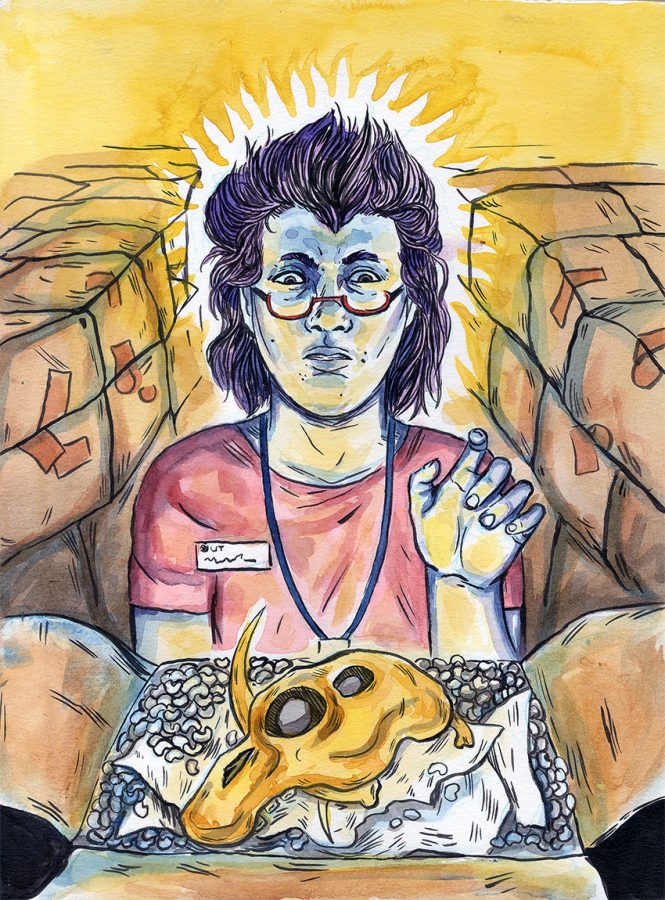Every day is like Christmas for paleontologists at the Jackson School of Geosciences’ Texas Vertebrate Paleontology Collections.
Matthew Brown, Director of Museum Operations at the fossil collection, said scientists have been working for decades to open numerous fossil “presents,” which contain specimens collected by the Works Progress Administration in the late 1930s and early 1940s.
Workers for the administration collected more than 10,000 fossils around the time of the Great Depression. According to Brown, some of the fossils were stored individually, while others were wrapped in plaster fossil jackets. Brown said that opening up one jacket can take months, and due to the manpower needed, approximately 40 of these jackets still remain unopened.
“It’s a fairly resource-intensive process to open the jackets and clean them,” Brown said. “We only do it if there is a strong research interest. Recently, there has been a resurgence. We have a couple of groups working on the various materials.”
Each jacket contains a whole block of earth dug out in the field, so opening one is a process of excavation in which the researchers remove the rock from around the bones layer by layer. As well as examining the bones, they also study the dirt removed under microscopes to get a better picture of the environment at the time.
“When things die and get buried, it’s not like Jurassic Park,” Brown said. “We’re not using a brush to uncover a beautiful, complete skeleton laid out on a flat plane. It’s usually a jumble or a pile — all kind of animals take bits and pieces [before it is buried]. We want to try and tell as much of the story of that animal’s life and death as we can.”
About two months ago, researchers discovered a new species of reptile from the Triassic Period, called Triopticus primus, hidden in the collection. According to Brown, the fossil had originally been misidentified, but more advanced technology revealed the mistake.
“It’s a really bizarre animal,” Brown said. “No one has really seen the likes of it before, especially from this time period. We hope to find out more information about this little guy. We have a tantalizing bit of skull, but we really want to see more of the skeleton.”
The remaining jackets are being unpacked by a few professional fossil preparators, as well as undergraduates in the Jackson School. While some jackets have detailed field notes, others contain unknown fossils, leading Brown to describe the project as a perpetual Christmas. As more of these jackets are opened, Brown said he is hopeful of finding more information about the prehistoric ecosystem of Texas as a whole.
Steve May, a research associate at the Jackson School, is studying fossils from Beeville to determine what the fauna of South Texas looked like 10-12 million years ago. According to May, people might be surprised to learn about the creatures that roamed prehistoric Beeville.
“There were five or six different kinds of horses, ranging from large-dog size to standard, modern-day sized,” May said. “There was a whole series of camels. It’s pretty interesting. There were also elephant-like animals with very large upper tusks. When you think of Beeville, you don’t usually think of elephant creatures running around.”
Although May said the large creatures are interesting, he is more focused on studying smaller mammals such as rodents. He said he has discovered a rabbit and a rodent similar to a small pocket gopher.
“I think that’s an important part of the fauna,” May said. “Rodents tell us about the environment, especially since some groups evolve quickly. It’s a part of the fauna that was lacking in terms of our understanding, and I’m personally interested in it.”
Brown added that many others have studied the fossils and will keep doing so.
“The process of studying will continue forever into the future,” Brown said. “That’s one of our missions here: to make sure these things are available to the public in perpetuity. They’ve been here for 80 years, and we want to keep it that way for another 80 years. A facility like this serves as an archive of the history of life.”















